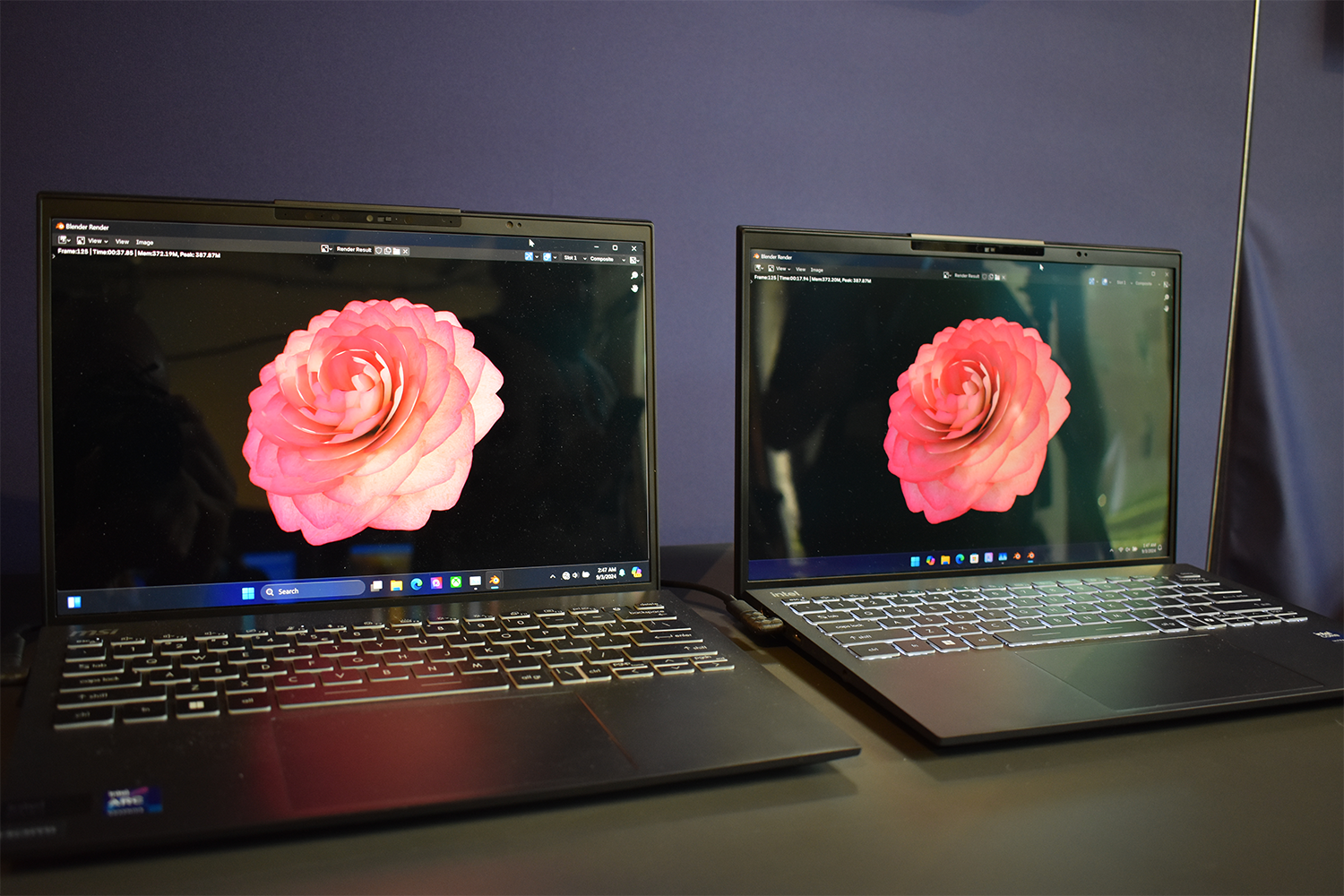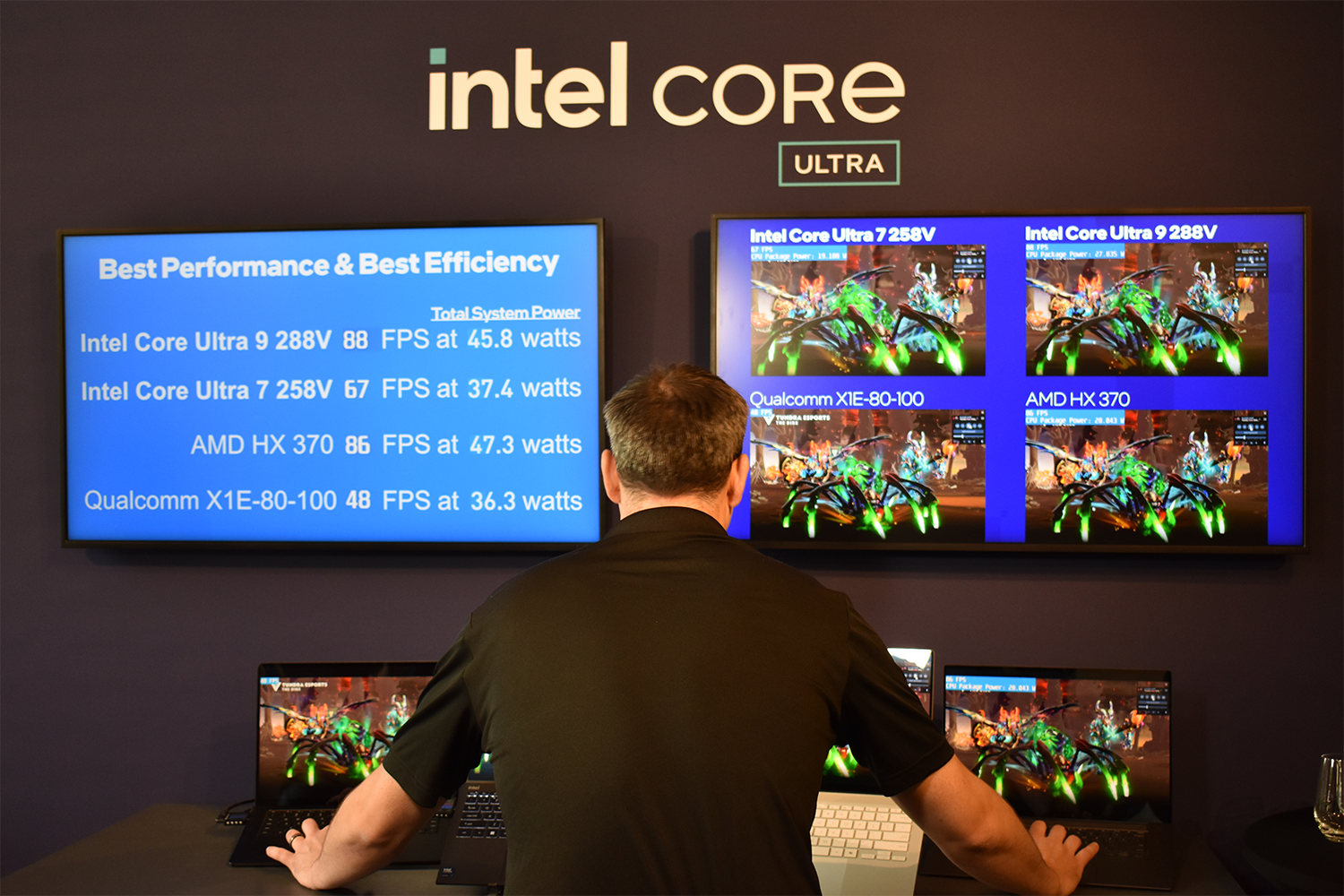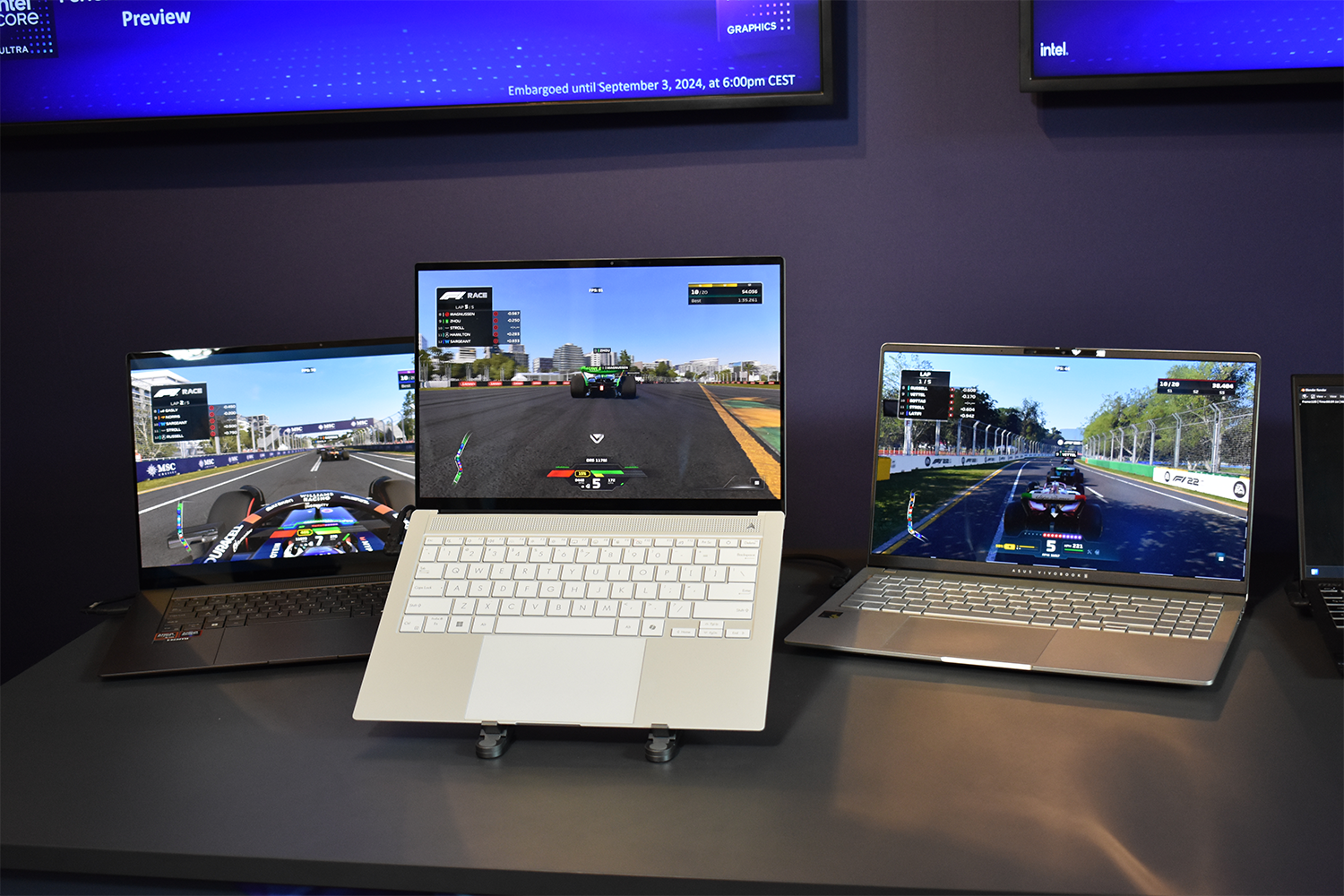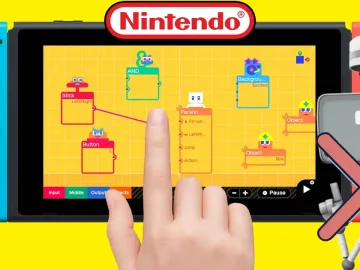Intel claims x86 architecture isn’t done yet, not by a long shot. After months of offering dribs and drabs of CPU details, the recently beleaguered chipmaker shared info on its Lunar Lake lineup, now officially dubbed the Intel Core Ultra 200V. Intel first helped bring us the term “AI PC” less than a year ago with its Meteor Lake chips. Now, instead of hammering home the promise of NPU processing, its plan to regain mobile chip supremacy is to point out how annoyingly limited Qualcomm’s ARM-based chips can be.
Intel calls its Core Ultra 200V lineup the “most efficient x86” chips available. The key measurement is a claimed 40% reduction in PHY power compared to last year’s Meteor Lake. It should use between 41% and 33% less power on Microsoft Teams or YouTube. In some productivity tasks, the power efficiency may be even higher. Intel says its PCs got 20 hours of battery life in Procyon benchmarks compared to the Snapdragon X Elite, though the ARM-based PC of the same make still got 12.7 hours of life compared to a little more than 10 hours for the Lunar Lake setup.
Photo: Kyle Barr / Gizmodo
There’s a wide selection of chips this time. The Lunar Lake lineup includes lower-power Intel Core Ultra 5 up to a top Core Ultra 9 288V. No matter what, you’re still getting a chip architecture that includes four efficiency cores and four power cores with eight threads. Besides power draw, the lower-end CPUs have a max frequency of 4.5 GHz with their P cores and an 8 MB cache. The Ultra 9 288V has a top 5.1 Ghz speed and a 12 MB cache. Unfortunately, there’s no Hyper-Threading integrated this time. Intel claims this leads to better power efficiency.
Intel is also dividing up its ARC-integrated GPU for the first time. If you go for an Intel Core Ultra 5, you get a 130V GPU. Anything Intel Core Ultra 7 and above gets a 140V GPU. The lower-end chips only get a 5x Gen4 NPU at a 40 TOPS. The chips with a 6x Gen4 NPU get 47 or more TOPS. Either way, they should meet the standards set by Microsoft to qualify for Copilot+ PC status, in case you’re one of the few who ever wants to eventually use Windows 11 Recall.
We’ll hear about OEM’s new Lunar Lake laptops in the next few days. More than Anything, Intel wants to beat AMD’s Strix Point lineup and, to a larger extent, beat that ARM upstart, the Qualcomm Snapdragon X Elite chip. The chips are on preorder now, and they should be available Sept. 24.
Intel’s Talking Much More Soberly About Lunar Lake’s NPUs Since the Advent of ‘AI PCs’
 Intel promises Lunar Lake can render scenes in Blender twice as fast as Meteor Lake. Photo: Kyle Barr / Gizmodo
Intel promises Lunar Lake can render scenes in Blender twice as fast as Meteor Lake. Photo: Kyle Barr / Gizmodo
As for AI processing, Intel says Core Ultra chips do 20% better than the Intel Core Ultra 7 155H in OIDN denoising using Blender and far better in AI upscaling or slo-mo effects in certain apps. The company likely chose those tests to showcase its new CPU in particular because the ARM-based Snapdragon chips can’t run Blender without emulation.
Today’s talk of AI processing is far different from last December when Intel CEO Pat Gelsinger (before he was trying to mollify concerned staff and investors with Bible verses) got up on stage to promote the glories of the NPU, or the neural processing unit. Intel has been hindered by problems with the power draw on its gaming-end 13th and 14th-gen chips, leading to repeat failures. Intel promised customers that these latest mobile chips won’t have the same issues.
On Tuesday, Robert Hallock, VP of Intel’s client computing group, said the NPU is more powerful. Still, it’s becoming another processing aspect of these new mobile chips, with processing split between CPU, GPU, and NPU. He compared it to the introduction of the integrated GPU, which was once “ridiculed” and is now an expected part of CPU processing.
He added the point computing experts and journalists have made for the past year: TOPS, or trillions of operations per second, isn’t a great way to compare neural processing capabilities. TOPS is a value derived through a simple math equation that includes a few parameters like speed and accuracy.
We should also point out that NPUs were not new with the advent of the AI PC. They’ve been part of phone designs for years. Intel never felt the need to create a whole new branding for PCs with graphics capabilities when it started close to 20 years ago. While the chipmaker wasn’t going as far as to say the NPU was overhyped, Hallock did say during a Q&A there was a “natural inclination” to focus on introducing dedicated neural processing. Now, app developers depend equally on all three aspects of modern CPUs, even for AI tasks.
Lunar Lake’s GPU may not be built solely for AI tasks, but it can handle 67 TOPS compared to the NPU’s 48. Ultimately, the NPU is built to handle light, AI assistant tasks, not generative AI for coding or graphics. In Intel’s demos with its new chip running Stable Diffusion AI art generator, the CPU depended more on GPU processing than NPU. AI clip segmentation in Adobe Premiere relied more on CPU than NPU.
Lunar Lake’s Big Claim to Fame is the Fact You Don’t Need to Emulate Anything on x86
 Photo: Kyle Barr / Gizmodo
Photo: Kyle Barr / Gizmodo
Intel claims the Lunar Lake is topping benchmarks, though we’ll need to get our hands on the first few laptops to verify those numbers. As for gaming performance, Intel claims its chips have better integrated graphics capabilities than Strix Point or Snapdragon. The company showed the Core Ultra 9 288V could get 10 to 20 more FPS in F1 2024 on high settings with no upscaling than a top-end AMD Ryzen AI 300 or around 30 more FPS compared to the Intel Core Ultra 7 155H.
It’s a similar story across more titles, with some impressive stated FPS at high settings, even if they don’t beat a laptop with a discrete graphics card.
Intel was also quick to point out that the vast majority of games built for x86 architecture won’t run without emulation. Microsoft and Qualcomm were the first in line to tell consumers the first Copilot+ PCs weren’t gaming machines. Intel’s top brass was keen to point out that ARM’s lack of total app support leaves them to play catch-up.
 Photo: Kyle Barr / Gizmodo
Photo: Kyle Barr / Gizmodo
That also misses the core comparison point between the two chip architectures. ARM PCs promise better optimization, leading to battery life exceeding 15 or 20 hours. Of course, that’s not necessarily true for every slim PC bearing the Copilot+ title, such as the Lenovo Yoga Slim 7x or Microsoft Surface Pro. Intel would need to break 10 hours to truly be impressive, so we’ll have to wait and see.
“x86 is more than capable of delivering faster graphics and faster core power and delivering on battery,” Hallock said during a Q&A. “I’ll probably go to my grave saying that it’s not the kind of chip; it’s the choices you make inside the CPU.”




